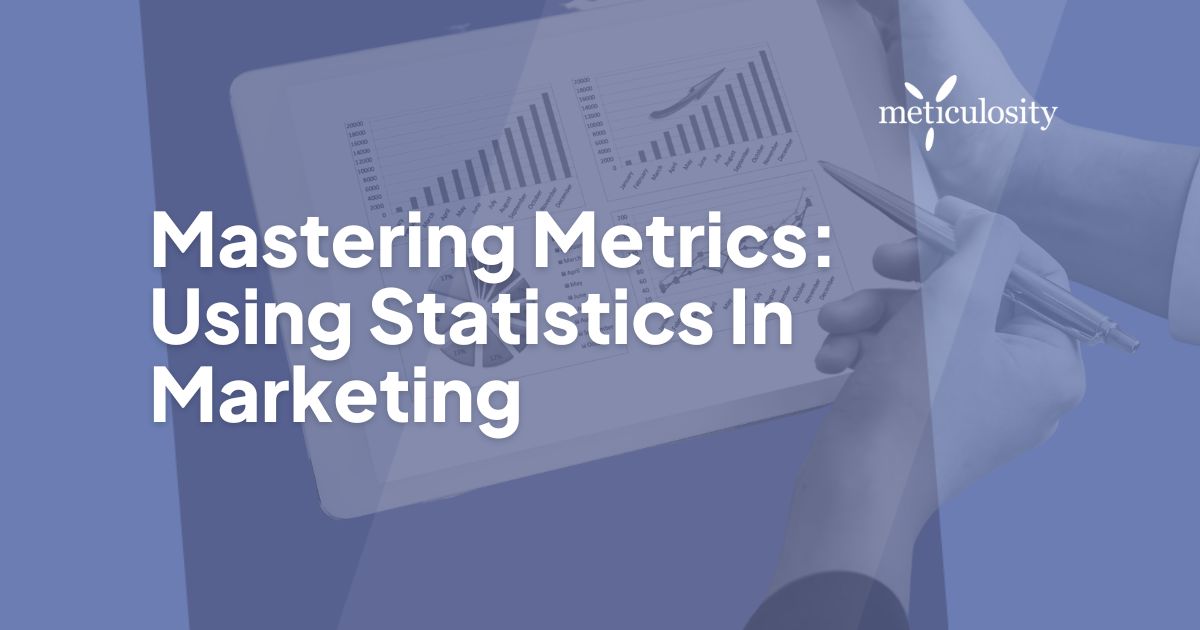In today's digital age, data is king. As a marketer, it is essential to understand how to leverage statistics to improve your marketing efforts and drive business results. In this blog, we will explore the importance of metrics for marketers and how you can use them to measure success across various digital channels such as SEO, social media, email marketing, and content creation.
We will also dive into the world of benchmarking and analyze key metrics for ecommerce success, PPC campaigns, influencer marketing, and more. Additionally, we will discuss how data-driven decision-making can help improve customer retention rates and analyze customer behavior with internet metrics. Lastly, we will explore future trends in marketing metrics and how they are set to evolve in an ever-changing digital world. So buckle up and get ready to master the art of using statistics in marketing!
How to Use Statistics in Digital Marketing
Measuring the effectiveness of marketing efforts is crucial for any marketer, and using statistics is a great way to achieve this goal. By utilizing A/B testing, marketers can compare the success of different marketing strategies, allowing them to optimize their campaigns efficiently.
Statistical analysis helps identify patterns in consumer behavior, which can then be used to predict future performance through forecasting methods. In today's digital era, learning how to use statistics in digital marketing is a must-have skill for any marketer or business owner.
The Importance of Metrics for Marketers
Measuring metrics like website traffic, conversion rates, and customer engagement marketers can gain valuable insights to improve their marketing strategies. Accurate tracking over time enables teams to measure the success of their campaigns against their ROI.

Furthermore, leveraging SEO tools such as Google Analytics helps digital marketers in goal setting. Similarly, Social Media platforms including LinkedIn, Instagram, and Twitter offer a great way to boost brand awareness through social media advertising. PPC advertising is an effective way for small businesses to generate leads further enhancing effective email marketing and video content creation.
Measuring SEO Success with Google Analytics
Google Analytics offers valuable insights to measure the success of digital marketing strategies by analyzing metrics such as organic traffic, bounce rate, and time on page. Tracking conversions using set goals helps determine the impact of SEO efforts on business outcomes. Regular analysis aids optimization of SEO strategies for desired results.
Calculating ROI with Metrics in Mind
Calculating ROI with metrics in mind is essential for every marketer to measure their marketing efforts' profitability. It involves knowing the total campaign cost and revenue generated from it.
Additionally, it's essential to consider factors such as CAC, CLV, and conversion rates while analyzing ROI. Marketers can use tools like Google Analytics or Google Ads for this purpose. Calculating these metrics can help optimize future marketing campaigns effectively.
Leveraging Instagram and Facebook Metrics for Success
Consistently tracking metrics on Instagram and Facebook is crucial for successful digital marketing strategies. Data-driven marketers analyze social media metrics such as reach, engagement, and conversion rates to identify growth opportunities and improve their campaigns.
The best way to utilize these stats is by optimizing campaigns accordingly to increase ROI without spending more money on traditional or digital advertising. By following these best practices and leveraging up-to-date marketing statistics from LinkedIn, Twitter, Hubspot, Google Analytics, Statista, and other sources marketers can make informed decisions about their social media marketing plan.
How Email Metrics Can Boost Your Campaigns
Regularly monitoring key metrics such as open rates, click-through rates, and conversion rates is critical when it comes to email marketing campaigns. By analyzing these metrics consistently over time, digital marketers can identify areas of improvement and make data-driven decisions to optimize their campaigns.
Keeping an eye on these KPIs helps in staying on top of trends and adjusting strategies accordingly for increased conversion rate and great ROI.
Understanding Marketing Statistics and Benchmarks
Digital marketers must track essential statistics or KPIs like conversion rates and customer lifetime value to measure their campaign's success. Comparing benchmark data against industry standards is crucial for understanding if your digital marketing strategy is working.
Social media platforms like Facebook and Twitter can be leveraged for tracking ROI on your campaigns. In addition to this, SEO using Google Analytics is recommended for measuring your website's ranking on search engines. Consistently optimizing metrics can lead to better brand awareness and higher conversion rates.
Key Metrics for E-commerce Success
For successful e-commerce, it's crucial to measure the right metrics like conversion rate, bounce rate, and average order value. These key metrics help identify where to focus your marketing strategies and optimize your digital marketing efforts using data-driven decisions.
Regularly monitoring these metrics ensures staying on top of trends while adjusting digital marketing tactics accordingly. Measuring these important stats not only helps businesses understand their target audience but also keeps them ahead of their competitors.
Navigating the World of PPC Metrics
To measure the success of online advertising campaigns effectively, digital marketers need to master Navigating the World of PPC Metrics. Essential metrics include Click-Through Rate (CTR), Conversion Rate, Cost Per Click (CPC), and Return on Ad Spend (ROAS).
Regularly monitoring these metrics helps optimize campaigns and boost their performance. Analyzing and mastering PPC metrics delivers valuable insights into audiences while improving overall return on investment.
Influencer Metrics That Matter
Utilizing influencers can be an effective way to boost brand awareness and reach your target audience through marketing strategies. Measuring influencer metrics like engagement rates, reach, and conversion rates is crucial for determining their impact on your ROI.
Engagement rates indicate how many social media users are interacting with an influencer's posts. Reach reflects the audience size that views the influencer's content on a social media platform. Conversion rates show how successful influencers are in driving their audiences towards performing certain actions like purchasing or signing up for newsletters.
Analyzing Metrics for Blog Success
Analyzing metrics for blog success is a critical aspect of every marketer's efforts. To achieve this goal effectively, you must use website analytics tools that help in tracking metrics like traffic, user engagement, and conversion rates.
Social media data analysis also helps in understanding audience demographics and engagement levels. Utilizing A/B testing is another great way to compare the effectiveness of different marketing strategies while monitoring email open rates and click-through rates significantly contributes towards successful email campaigns.
How Metrics Can Improve Your Content Strategy
Analyzing metrics is a great way for any marketer to tailor their content to the interests of their target audience. By keeping track of engagement levels, conversion rates, and other relevant KPIs, digital marketers can measure the success of specific campaigns or promotions.
Regularly reviewing and analyzing metrics can help make data-driven decisions that improve marketing efforts—whether it's SEO best practices for Google ranking or social media advertising tips for LinkedIn or Instagram. By using metrics to track everything from email open rates to video content performance, businesses—big or small—can maximize the effectiveness of their digital marketing tactics.
Creating Compelling Headlines with Stat Analysis
Crafting compelling headlines with statistical analysis is a great way to communicate the value of your content to readers and boost brand awareness without starting with ‘How To Use Statistics in Digital Marketing.’ Marketing teams should use two or at most three paragraphs in their content for better readability and smoother flow from the previous topic.

Using tools like Google Analytics or Statista provides valuable insights into the performance of your blog headlines. Regularly reviewing metrics can improve your digital marketing efforts.
Utilizing Metrics for Effective Content Distribution
Analyzing metrics such as page views, bounce rate, and dwell time is the best way to determine which types of content resonate most with your target audience. By utilizing these essential marketing strategies for effective content distribution, you can make data-driven decisions to improve your marketing efforts continually.
Additionally, tracking the success of your digital marketing campaigns with Google Analytics or other analytics tools helps in identifying areas for improvement and optimizing your conversion rate.
The Power of Data-Driven Decision Making
Data-Driven Decision Making is a great way to improve your digital marketing strategies. By collecting and analyzing data, you can gain valuable insights into your target audience's behavior and preferences.
This can help you identify patterns and trends in your marketing performance, leading to improved ROI. A/B testing, experimentation, and regular metric reviews are all crucial for refining your tactics based on data insights. With the right approach, you can make the most out of your digital marketing efforts without overspending on the marketing budget.
Using Metrics to Improve Customer Retention Rates
Improving customer retention rates is crucial for any marketer or business owner looking to increase revenue and achieve sustainable growth. Measuring churn rate, customer lifetime value (CLV), and net promoter score (NPS) are some of the best practices for tracking customer retention rates.
Analyzing these metrics provides valuable insights into customer behavior that can inform marketing strategies aimed at retaining more customers. By focusing on data-driven decision-making and implementing effective marketing tactics based on insights gleaned from metrics analysis, businesses can boost their revenue and drive long-term success.
Analyzing Customer Behavior with Internet Metrics
To optimize digital marketing strategies, it's crucial for marketers to analyze customer behavior using internet metrics like website traffic and bounce rates. Analyzing data helps identify areas for improvement in marketing efforts and refine tactics based on customer behavior insights.
With a data-driven approach to refining digital marketing strategies comes increased ROI. Utilizing SEO best practices alongside Google Analytics and social media platforms like Instagram will improve a brand's reach online and lead to more conversions.
The Role of Benchmarks in Goal Setting
Benchmarks are critical in goal setting for digital marketers. They act as points of reference that allow businesses to achieve measurable and realistic objectives while tracking their progress.
Benchmarks also help identify areas of improvement by providing valuable insights into industry standards, such as ROI or KPIs. By tracking performance over time, businesses can adjust their marketing strategies accordingly and optimize campaigns for better results using data-driven decision-making.
Looking Ahead: Future Trends in Marketing Metrics
As the world moves towards an increasingly digital future, digital marketers are finding new and innovative ways to analyze data. By implementing artificial intelligence and machine learning technologies for predictive modeling, they can stay ahead of the curve.
Furthermore, omnichannel marketing is becoming increasingly important in today's landscape. In order to measure success accurately, it is essential to take into consideration factors such as engagement metrics (such as time spent on social media platforms or websites), customer lifetime value and branding impact measurements.
The Evolution of Social Media Metrics
Social media platform analytics have come a long way from evaluating likes and shares. Currently, it includes sentiment analysis, and micro-metrics that measure specific actions taken by users such as scrolling or hovering over items on the page.

Future trends predict the use of video analytics for influencer tracking. When measured correctly with effective tools, these insights can help digital marketers optimize their social media marketing campaigns for better user engagement rates.
The Impact of Artificial Intelligence on Marketing Analytics
Artificial intelligence has revolutionized marketing analytics by enabling real-time data analysis and personalized insights. AI-powered tools assist marketers in lead scoring, customer segmentation, and predictive modeling to improve ROI. However, it is crucial for marketers to consider ethical considerations like maintaining user privacy and avoiding biased algorithms in their digital marketing efforts.
The Future of Metrics in an Ever-Changing Digital World
As the digital world is constantly evolving, marketers need to keep pace with the changes by adopting new technologies like AI and machine learning to gather and analyze data. Future marketing efforts will center around metrics that focus on customer experience and engagement, with a balance of quantitative data and qualitative insights.
Accurately measuring ROI will remain crucial for digital marketers who want to improve their marketing strategies for social media (such as Instagram, Facebook, Twitter, and LinkedIn), PPC campaigns (like Google Ads), SEO optimization (using tools like Google Analytics), email marketing campaigns, video content creation, influencer tracking, mobile device apps, and online advertising efforts.
Conclusion
In conclusion, statistics and metrics play a crucial role in marketing success. From measuring the effectiveness of SEO to analyzing customer behavior, data-driven decision-making is essential for marketers to achieve their goals. Understanding key metrics, navigating benchmarks, and keeping up with evolving trends can help you stay ahead of the competition.
By utilizing metrics effectively, you can improve your content strategy, boost customer retention rates and increase ROI. Keep learning about emerging trends and strategies in marketing analytics by subscribing to our newsletter or contacting our experts for a personalized consultation.








